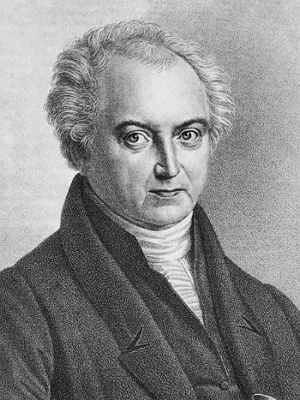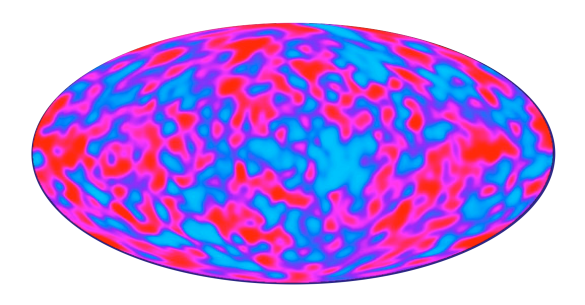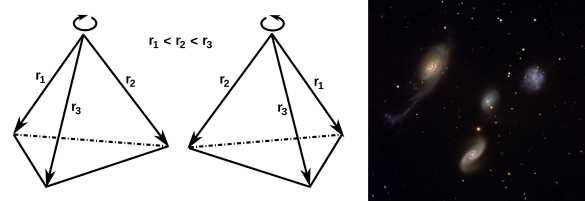Cosmic Asymmetry
September 11, 2023
Hypothesis is one of the
engines that drives
scientific progress, and an important part of
hypothesis formation is the power of
analogy.[1] As
George Pólya wrote in his 1945
book,
How to Solve It,
"Analogy pervades all our thinking, our everyday speech and our trivial conclusions as well as artistic ways of expression and the highest scientific achievements."
An
unusual example of analogy in
astronomy is the
comparison between
trees in a
forest and the
stars in the
sky. When you're in a small
stand of trees, it's possible to
peer through the
empty spaces to see what's outside. As the number of trees gets larger, the additional trees block your view of the outside world, and there's a point at which you can't see the outside world at all.
If we consider stars instead of trees, a very large, or
infinite,
universe will have a star everywhere we look. As a consequence, the
night sky should not be
dark, but
lighted. The distant stars would be
dim, but each distant star will cover just a small
angular patch of sky. There's a compensating mechanism in which the
intensity of
light falls as the square of distance, but the
surface area of a
sphere at that distance is larger by the square of the distance.
The
paradox of the dark night sky is called
Olbers' paradox. It's named after the
German astronomer,
Heinrich Wilhelm Matthias Olbers (1758-1840), but Olbers wasn't the first to have this
idea.

German astronomer, Heinrich Wilhelm Matthias Olbers (1758-1840).
Although Olbers' paradox is named after Olbers, who stated it in 1823, many others deserve some credit, including Johannes Kepler (1571-1630), Edmond Halley (1656-1742), and Jean-Philippe de Cheseaux (1718-1751). Kelvin (1824-1907), who had opinions on many scientific matters, gave one resolution of the paradox in a 1901 paper.
(Lithograph by Rudolf Suhrlandt (1781-1862), via Wikimedia Commons.)
Since the night sky is dark, there's the
facile argument that the number of stars is
finite, and this was
Kepler's argument. As late as the first part of the
20th century, many astronomers
still believed that our
Milky Way Galaxy was all there was to the universe. Another
explanation is that
obscuring dust clouds might be the cause. However,
thermal equilibrium would eventually cause the dust clouds to glow as brightly as the stars whose
energy they
absorbed, and this explanation fails.
We now believe that we inhabit a universe of at least 2 trillion
galaxies that had a
precise origin in an event called the
Big Bang 13.787 ± 0.020 billion years ago. At
large scale, our universe appears to be both
homogeneous and
isotropic. This is evidenced by detailed
observation of the
cosmic microwave background radiation (CMBR) in 1989-1993 by the
Cosmic Background Explorer (COBE) satellite observatory. COBE observed the
thermal black body spectrum of the
remnant radiation of the Big Bang (see figure).

Cosmic Background Explorer (COBE) false color image of the detected small variation (36 μK between blue and red) in the cosmic microwave background radiation (CMBR). (NASA image of the COBE Science Working Group. Click for larger image.)
While the isotropy of the universe is settled as far as the cosmic microwave background radiation is concerned,
scientists always look to understand things from more than one
perspective. An interesting example is a feature of the
theory of
closed timelike curves proposed by
mathematician,
Kurt Gödel (1906-1978), who is
famous for his
incompleteness theorem that
casts doubt on the possibility of certain
mathematical proofs.
Gödel suffered periods of
mental instability towards the
end of his life, and he seemed to be
obsessed with the idea of his
mortality. His proposed closed timelike curves would be a means for both the universe and his own self to be
reincarnated repeatedly. One
consequence of this theory was a preferred
spin axis for galaxies. As
John Wheeler (1911-2008) explained, Gödel found that observations did not support his theory.[2]
"It turned out that he, himself, had taken out the great atlas of the galaxies and, page after page, had opened it up and looked at each galaxy, determined the direction of its axis, he made a statistics of these numbers, and found there was no preferred direction of rotation..."[2]
Despite such failed attempts, searches for some sort of cosmic asymmetry are still being done. In a recent
open access article in the
Monthly Notices of the Royal Astronomical Society,
Jiamin Hou of the
University of Florida (Gainesville, Florida),
Zachary Slepian and
Robert N. Cahn of
Lawrence Berkeley National Laboratory (Berkeley, California) have examined the
parity (
reflection symmetry) of
clusters of galaxies forming a
tetrahedron in
space when the galaxies serve as
vertices joined by connecting
lines.[3-5]
A tetrahedron with its four
triangular faces is the simplest of all the ordinary
convex polyhedra. A regular tetrahedron, with its four identical
equilateral triangle faces, has reflection symmetry defined by six
bisecting planes, and a tetrahedron with two equal
sides will have one such plane. However, the
probability is small that a tetrahedron formed from four
randomly placed vertices would have any mirror planes; so, in general, tetrahedra can be classified as either
clockwise or
counter-clockwise (see figure).

In the tetrahedrons pictured, each vertex represents a galaxy. Choosing the topmost galaxy as the primary, there are three vectors pointing from it to the other vertices. Viewing the tetrahedron from the topmost galaxy looking down, the direction from smallest to largest side determines a clockwise or counter-clockwise rotation. The leftmost here is clockwise.
On the right is an image of a tetrahedral arrangement of galaxies known as Robert's Quartet. This compact clusters of galaxies composed of NGC 87, NGC 88, NGC 89, and NGC 92 is approximately 160 million light-years away in the constellation, Phoenix. It was discovered by John Herschel (1792-1871) on September 30, 1834.
(Left and center images created using Inkscape. The rightmost image is a European Southern Observatory image from Wikimedia Commons. Click for larger image.)
Oliver Philcox, an
astrophysicist at
Columbia University (New York, New York) published a study in
Physical Review D in September, 2022, in which he considered galaxies to be vertices of tetrahedra.[5] Philcox found a small imbalance in the numbers of tetrahedra of each parity (clockwise or counter-clockwise rotation).[5] Cahn decided to look for such parity violation in a million galaxies as
cataloged in the
Sloan Digital Sky Survey and luminous red galaxies of its
Baryon Oscillation Spectroscopic Survey twelfth data release.[3-5]
For
analysis, Cahn's team used the
4-point correlation function (4PCF) to ascertain an imbalance between such tetrahedra and their mirror images.[3-4] The million galaxy
dataset yielded nearly 10
24 tetrahedra.[5] The result was a parity imbalance that exceeded 7.1
standard deviations (
seven-sigma), a very definitive result.[3-5] Five sigma is the standard for discovery in
particle physics.
If there is a true cosmological asymmetry, it must arise from an
epoch of the
expansion of space known as
inflation.[3-4] During inflation,the universe rapidly expanded to 10
26 times its original size, and small
quantum fluctuations of
particles were amplified to affect the
density of
matter. The denser regions continued to
gravitationally coalesce to produce the galaxies and large-scale structure we see today.[5]
As they say, "
extraordinary claims require extraordinary evidence." Cahn and his colleagues have examined many possible sources of
systematic error in their study, and they've found none that contradicts their finding of cosmic asymmetry.[3-4] The
authors write that this 4PCF approach is a possible approach to examining details of the inflation epoch when augmented with
data from newer galaxy surveys, such as the presently 14 million galaxies of the
Dark Energy Spectroscopic Instrument (DESI) survey.[3-4] The pattern found for the cosmic microwave background radiation should also contain parity-violating
correlations.[5]
References:
- Dedre Gentner and Michael Jeziorski, "Historical Shifts in the Use of Analogy In Science," Technical Report No. 498, Center for the Study of Reading, University of Illinois at Urbana-Champaign, April 1990 (via Northwestern University).
- John Wheeler - Kurt Gödel and the Closed Time-like Line, YouTube video by Web of Stories - Life Stories of Remarkable People, Oct 6, 2017.
- Jiamin Hou, Zachary Slepian, and Robert N Cahn, "Measurement of parity-odd modes in the large-scale 4-point correlation function of Sloan Digital Sky Survey Baryon Oscillation Spectroscopic Survey twelfth data release CMASS and LOWZ galaxies," Monthly Notices of the Royal Astronomical Society, vol. 522, no. 4 (July 2023), pp. 5701-5739, https://doi.org/10.1093/mnras/stad1062
- Jiamin Hou, Zachary Slepian, and Robert N. Cahn, "Measurement of Parity-Odd Modes in the Large-Scale 4-Point Correlation Function of SDSS BOSS DR12 CMASS and LOWZ Galaxies," arXiv, June 23, 2023, https://doi.org/10.48550/arXiv.2206.03625.
- Katie McCormick, "Asymmetry Detected in the Distribution of Galaxies," Quanta Magazine, December 5, 2022.
Linked Keywords: Hypothesis; engine; scientific progress; speculative reason; hypothesis formation; analogy; George Pólya; write; book; How to Solve It; thought; thinking; speech; trivia; trivial; art; artistic; strange; unusual; astronomy; comparison; tree; forest; star; sky; stand; sight; peer; hole; empty space; infinity; infinite; universe; night sky; darkness; dark; lightness; lighted; dim; solid angle; angular patch; intensity (physics); light; inverse-square law; falls as the square of distance; surface area; sphere; paradox; Olbers' paradox; Germany; German; Heinrich Wilhelm Matthias Olbers (1758-1840); idea; astronomer; eponym; named after; credit; Johannes Kepler (1571-1630); Edmond Halley (1656-1742); Jean-Philippe de Cheseaux (1718-1751); William Thomson, 1st Baron Kelvin (1824-1907); opinion; science; scientific; scientific inquiry; resolution; scientific literature; paper; Wikimedia Commons; facile; argument; 20th century; Great Debate (astronomy); belief<; Milky Way Galaxy; explanation; cosmic dust; obscuring dust cloud; thermal equilibrium; energy; absorption (electromagnetic radiation); absorb; galaxy; galaxies; cosmogony; origin; Big Bang; age of the universe; 13.787 ± 0.020 billion year; spatial scale; large scale; homogeneity and heterogeneity; homogeneous; isotropy; isotropic; observational astronomy; observation; cosmic microwave background radiation (CMBR); Cosmic Background Explorer (COBE); space observatory; satellite observatory; thermal black body spectrum; remnant radiation; COBE image of the detected small variations in the cosmic microwave background radiation (CMBR); Cosmic Background Explorer (COBE); false color image; detector (radio); detected; kelvin; K; NASA; COBE Science Working Group; scientist; point of view (philosophy); perspective; theory; closed timelike curve; mathematician; Kurt Gödel (1906-1978); celebrity; famous; incompleteness theorem; uncertainty; doubt; mathematical proof; mental disorder; mental instability; life expectancy; end of his life; idée fixe (psychology); obsession; mortality; reincarnation; reincarnated; logical consequence; rotation; spin axis; John Archibald Wheeler (1911-2008); New General Catalogue; atlas of the galaxies; page (paper); direction vector; statistic; open access article; Monthly Notices of the Royal Astronomical Society; Jiamin Hou; University of Florida (Gainesville, Florida); Zachary Slepian; Robert N. Cahn; Lawrence Berkeley National Laboratory (Berkeley, California); parity (physics); reflection symmetry; galaxy cluster; cluster of galaxies; tetrahedron; three-dimensional space; vertex (geometry); vertices; line segment; lines; triangle; triangular; face (geometry); convex polytope; convex polyhedra; Platonic solid; equilateral triangle; bisection; bisecting; edge (geometry); side; probability; randomness; randomly; clockwise; counter-clockwise; Euclidean vector; rotation (mathematics); Robert's Quartet; NGC 87; NGC 88; NGC 89; NGC 92; light-year; constellation; Phoenix (constellation); John Herschel (1792-1871); Inkscape; Oliver Philcox; astrophysicist; Columbia University (New York, New York); Physical Review D; star catalogue; cataloged; Sloan Digital Sky Survey; Baryon Oscillation Spectroscopic Survey (BOSS); data analysis; correlation function (statistical mechanics); 4-point correlation function (4PCF); dataset; standard deviation; seven-sigma; particle physics; epoch (astronomy); expansion of space; inflation (cosmology); quantum fluctuation; elementary particle; density; matter; gravitation; gravitationally; coalescence (physics); coalesce; aphorism; As they say; Sagan standard; extraordinary claims require extraordinary evidence; systematic error; author; data; Dark Energy Spectroscopic Instrument (DESI); correlation function; correlation.